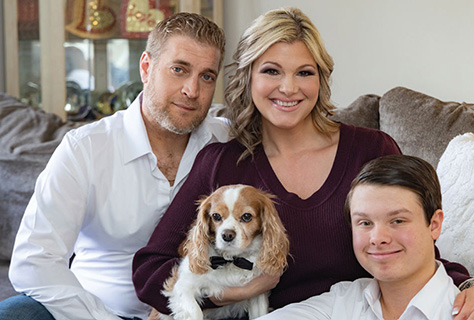I take nothing for granted now.

Two-and-a-half years ago, Dana Zika was a busy, healthy 41-year old with a young son, a full-time job as a kindergarten teacher and a part-time job as a hostess at the Kenilworth Diner. Then, as she was finishing her shift at the diner one night, her heart stopped.
“It was the day after Thanksgiving, 2019, and I hadn’t been scheduled to work that night; I was filling in for a coworker,” she recalls. “I wasn’t feeling great. I started to sweat for no reason. I just wanted to finish cleaning up and go home. I sat down on a bench to chat with my boyfriend, who had come in after work for dinner, and a coworker. That’s the last thing I remember.”
As she was sitting at the table, she suddenly slid from the bench to the ground, where she lay without moving. Her boyfriend and coworkers soon realized that she wasn’t breathing and frantically called 911.
A series of very fortunate coincidences combined to save Zika’s life. “I really think everything aligned that night,” she says. “I wasn’t alone at home, but in a public place. My boyfriend was there to start CPR; he was the only one in the diner who knew how to do it. Also, the ambulance happened to be very close by and was at the diner in minutes. And the police officer who arrived to use the AED [automated external defibrillator] machine was the one who trains other officers in its use. He knew exactly what he was doing.”
A Rare Disorder
By the time Zika arrived at Newark Beth Israel Medical Center (NBI), the defibrillator had shocked her heart into restarting, and her heart function had returned to normal.
“Her initial EKG showed a prolonged QT interval [a measurement of the electrical system], which normalized after stopping one of her medications. Otherwise, her cardiac workup was pretty unremarkable,” says cardiologist Marc Roelke, MD, Director of Electrophysiology at NBI and a member of RWJBarnabas Health Medical Group. “She had a normal echocardiogram, normal cardiac MRI and a normal CT angiogram [a scan of the coronary arteries] showing that her heart was structurally normal.”
The diagnosis: Zika has acquired Long QT syndrome. “When she’s not on specific medications, she doesn’t have arrhythmia related to Long QT, but certain medications make it more likely,” explains Dr. Roelke. In Zika’s case, the arrhythmia was instigated by a drug she’d >been taking for nerve pain for several years. Zika realized that the dizzy spells she’d been experiencing on and off had been the first symptoms of the problem.
Zika stayed at NBI for almost two weeks. During that time, she had a defibrillator implanted under the skin of her left arm. If her heart ever started beating abnormally or stopped again, the defibrillator would shock it back into regular rhythm.
Zika went back to work, school and her then 12-year-old son, Aiden. She thought her ordeal was behind her. But she had one more cardiac challenge to face.
An Unrelated Episode
In early 2021, Zika was again working at the diner when she realized her heart was beating extremely fast. All of a sudden, her defibrillator went off. “My whole body jerked backwards, my knees buckled,” she recalls. She was rushed to the emergency department. There, Zika’s heart rate measured 228 beats per minute (normal resting heart rate is 60 to 100).
While doctors were examining her, they discovered that her rapid heartbeat had been triggered by another cardiac abnormality, called supraventricular tachycardia (SVT), which was unrelated to Long QT syndrome. “SVT is a completely separate cardiac problem,” Dr. Roelke explains. “It’s an abnormal heart rhythm condition caused by an extra electrical pathway in the heart.”
To deal with the condition, Dr. Roelke recommended that Zika have a cardiac ablation to eliminate the extra pathway.
The surgery took place this past October. She’s now recovered and back to her usual activities and work schedule. She has not had any further shocks from the defibrillator. “Dr. Roelke says the device is my insurance policy,” she says. With it, she can look forward to a normal life expectancy.
“I take absolutely nothing for granted now,” she says. “I could care less about material things. A great day for me is a normal routine: waking up, going to work, sitting in my backyard with my family, watching my son play in the school band. I appreciate so much more now.”
With her own health under control, Zika has talked to coworkers and friends about getting trained to do CPR and to getting more defibrillators into public spaces. And she encourages people to always listen to their body and to follow up with a doctor when something feels “off,” even if they think it’s something minor or inconsequential.
“Everyone should be required to take a CPR course and be trained to use an AED,” she says. “It’s so simple—a few hours out of your time and you could save someone’s life.”
How to Save a Life
Dana Zika was lucky to have people trained in cardiopulmonary resuscitation (CPR) and the use of an automatic external defibrillator (AED) nearby when she needed them. To learn about community classes in cardiac first aid offered by RWJBarnabas Health, visit www.rwjbh.org/CPR.
Whoever your heart beats for, our hearts beat for you. To connect with a top cardiovascular specialistat Newark Beth Israel Medical Center, call 888-724-7123 or visit our website.